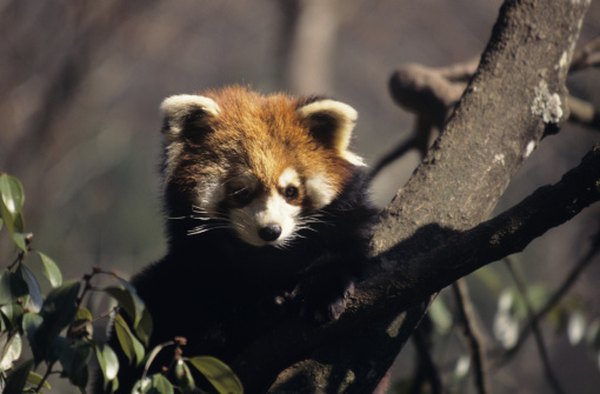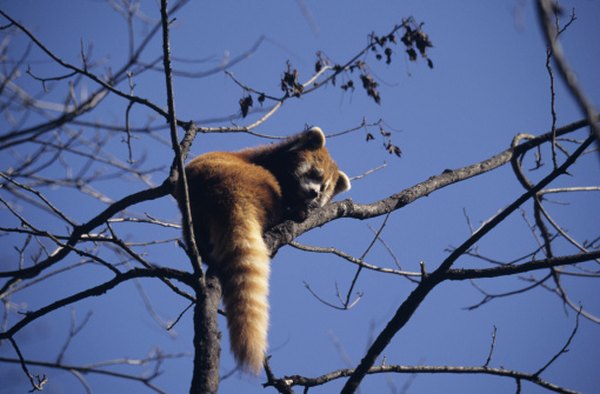What Animal Has Wide Teeth And Powerful Jaws For Chewing Tough Bamboo Leaves
Red pandas are cat-sized mammals native to thick mountainous forests of the Himalayas and surrounding regions of southwestern China and Myanmar. Arresting in advent with their large ears, dense cinnamon coats and long, striped tails, these more often than not nocturnal creatures are, despite their proper noun, more closely allied with raccoons and mustelids (weasels) than with the much larger giant panda that shares some of their range.
Threatened by habitat loss, red pandas are inherently at chance considering of their relatively restricted nutrition. While they sometimes feed on minor animals and other plants, most of their food comes in the grade of widely abundant but nutritionally challenging bamboo. Red pandas adaptations take helped them survive although they tin can't e'er help against their biggest threat: humans.
Ruby-red Panda Facts
The red panda'due south scientific name is Ailurus fulgens. It's office of the ailuridae family unit, but it is now the last existing species inside this family unit every bit all of the other species within it have gone extinct. Unfortunately, that may exist the fate of this animal equally well. They're virtually the size of a firm true cat with distinctive auburn fur.
It's on the endangered species list with less than ten,000 full individuals left in the wild. It's small habitat range has been severely impacted by climatic change and man overuse. They're besides often poached for their furs and they are also hunted accidentally later on they get defenseless in traps set for other animals.
Dentition

••• Tom Brakefield/Stockbyte/Getty Images
The red panda has massive jaws relative to its size; its broad skull supports the attachment of stiff chewing muscles. Information technology besides has 38 robust teeth. These adaptations help it brew upwardly bamboo shoots and leaves, and somewhat mirror those found in the giant panda, which also has heavy dentition and jaw muscles.
Red pandas tend to be more discriminating in their browsing, however. Where behemothic pandas volition swallow nearly every above-ground role of a bamboo plant in a rough manner, the red panda ordinarily selects the more tender new growth of stem and leaf, and chews more than fastidiously.
"Thumb"
Another morphological similarity between the giant panda and the red panda is a thumb-similar spur on the forepaw. While not a true pollex, this growth -- a modified radial sesamoid bone -- has evolved to fulfill a similar role: bracing a shoot of bamboo while the panda gnaws or clips off leaves.
Arboreal Habits

••• Tom Brakefield/Stockbyte/Getty Images
Cherry pandas are first-class climbers, sleeping during the day and seeking protection from predators in trees. Flexible paws give them the maneuverability necessary to descend a body headfirst, to leap from branch to co-operative and to secure themselves in an arboreal nook for sleeping. The paws are furred on the sole, bolstering their traction on slippery co-operative-tops.
The animals sport sharp, semi-retractable claws for climbing. The red panda's long, luxuriously coated tail is an fantabulous balancing rod for canopy locomotion.
Red Panda Adaptations: Behavioral
Like giant pandas, red pandas must feed often and extensively because they possess the elementary digestive tract of a carnivore and are thus inefficient processors of their cellulose-heavy bamboo fodder. They may spend 13 hours a 24-hour interval foraging on bamboo, and practise their all-time to conserve free energy on this low-nutrition diet.
They stay warm during winter cold with thick fur coats and past curling their long tails around them while sleeping; they maintain large dwelling house ranges that overlap broadly to reduce feeding pressure in any one area. Energy expenses are greatest for significant and nursing females -- the Philadelphia Zoo reports a lactating mother may need to eat 3 times the normal quantity of bamboo to produce adequate milk -- and the development of the cubs is slow and drawn-out.
Source: https://sciencing.com/red-pandas-adaptations-8467273.html
Posted by: ogrentherong.blogspot.com

0 Response to "What Animal Has Wide Teeth And Powerful Jaws For Chewing Tough Bamboo Leaves"
Post a Comment